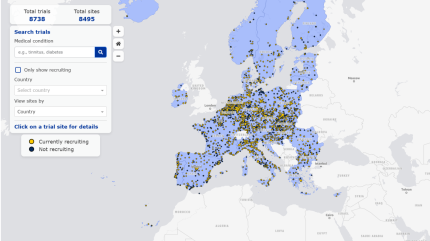
The European Union (EU) has released a clinical trial map as part of the Clinical Trials Information System (CTIS) to help patients and healthcare professionals find ongoing studies in their area.
The map builds on public information contained in CTIS, providing an accessible way to search for ongoing trials by geographic area and medical condition. The system will provide real-time information about clinical trials to patients to increase access to clinical research in the EU.
The creation of the map is an action of the Accelerating Clinical Trials in the European Union (ACT EU) initiative workplan for 2025 and 2026.
Search results offer investigator’s contact details, allowing patients to directly enquire about enrolment on a trial. The first version of the map is provided in English, but additional European languages will be added in future releases.
CTIS includes a public searchable database for healthcare professionals, patients and citizens to deliver the high level of transparency provided by the Clinical Trials Regulation (CTR), which came into full force on 31 January 2025. Although the rollout has been generally successful, some industry experts have shared concerns about the level of interpretation in the CTR, causing sponsors to be unsure whether they had correctly filed a clinical trial.
The authorisation and oversight of clinical trials is the responsibility of EU/EEA Member States while the European Medicines Agency (EMA) is responsible for maintaining CTIS. The European Commission oversees the implementation of the Clinical Trials Regulation.
The CTIS launched in January 2022 and sponsors have had to file new trials to the system since 31 January 2023. Sponsors had to transfer all trials, including ongoing trials, from the Clinical Trial Directive (CTD) to the CTIS by 31 January 2025.
Patient recruitment remains a pain point for sponsors and can lead to trial terminations worldwide. Last month, experts attending the Arena International Outsourcing in Clinical Trials (OCT) West Coast 2025 conference shared possible solutions to create more patient-centric studies to improve patient recruitment and retention.



